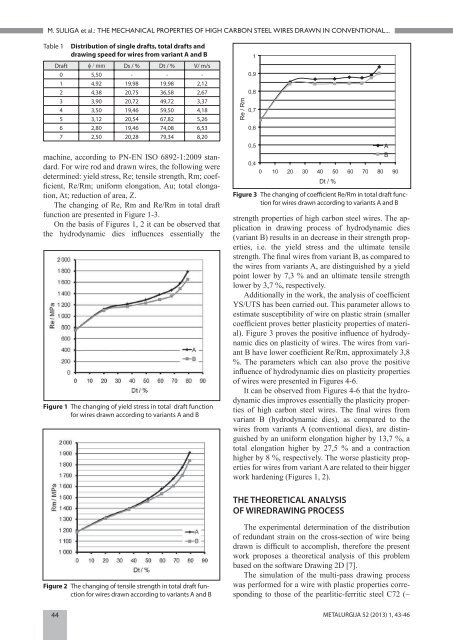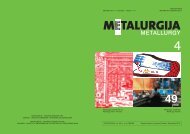Metalurgija: sadašnjost Metallurgy: Present Metalurgija ... - CARNet
Metalurgija: sadašnjost Metallurgy: Present Metalurgija ... - CARNet
Metalurgija: sadašnjost Metallurgy: Present Metalurgija ... - CARNet
Create successful ePaper yourself
Turn your PDF publications into a flip-book with our unique Google optimized e-Paper software.
M. SULIGA et al.: THE MECHANICAL PROPERTIES OF HIGH CARBON STEEL WIRES DRAWN IN CONVENTIONAL...<br />
Table 1 Distribution of single drafts, total drafts and<br />
drawing speed for wires from variant A and B<br />
Draft φ / mm Ds / % Dt / % V/ m/s<br />
0 5,50 - - -<br />
1 4,92 19,98 19,98 2,12<br />
2 4,38 20,75 36,58 2,67<br />
3 3,90 20,72 49,72 3,37<br />
4 3,50 19,46 59,50 4,18<br />
5 3,12 20,54 67,82 5,26<br />
6 2,80 19,46 74,08 6,53<br />
7 2,50 20,28 79,34 8,20<br />
machine, according to PN-EN ISO 6892-1:2009 standard.<br />
For wire rod and drawn wires, the following were<br />
determined: yield stress, Re; tensile strength, Rm; coeffi<br />
cient, Re/Rm; uniform elongation, Au; total elongation,<br />
At; reduction of area, Z.<br />
The changing of Re, Rm and Re/Rm in total draft<br />
function are presented in Figure 1-3.<br />
On the basis of Figures 1, 2 it can be observed that<br />
the hydrodynamic dies infl uences essentially the<br />
Figure 1 The changing of yield stress in total draft function<br />
for wires drawn according to variants A and B<br />
Figure 2 The changing of tensile strength in total draft function<br />
for wires drawn according to variants A and B<br />
strength properties of high carbon steel wires. The application<br />
in drawing process of hydrodynamic dies<br />
(variant B) results in an decrease in their strength properties,<br />
i.e. the yield stress and the ultimate tensile<br />
strength. The fi nal wires from variant B, as compared to<br />
the wires from variants A, are distinguished by a yield<br />
point lower by 7,3 % and an ultimate tensile strength<br />
lower by 3,7 %, respectively.<br />
Additionally in the work, the analysis of coeffi cient<br />
YS/UTS has been carried out. This parameter allows to<br />
estimate susceptibility of wire on plastic strain (smaller<br />
coeffi cient proves better plasticity properties of material).<br />
Figure 3 proves the positive infl uence of hydrodynamic<br />
dies on plasticity of wires. The wires from variant<br />
B have lower coeffi cient Re/Rm, approximately 3,8<br />
%. The parameters which can also prove the positive<br />
infl uence of hydrodynamic dies on plasticity properties<br />
of wires were presented in Figures 4-6.<br />
It can be observed from Figures 4-6 that the hydrodynamic<br />
dies improves essentially the plasticity properties<br />
of high carbon steel wires. The fi nal wires from<br />
variant B (hydrodynamic dies), as compared to the<br />
wires from variants A (conventional dies), are distinguished<br />
by an uniform elongation higher by 13,7 %, a<br />
total elongation higher by 27,5 % and a contraction<br />
higher by 8 %, respectively. The worse plasticity properties<br />
for wires from variant A are related to their bigger<br />
work hardening (Figures 1, 2).<br />
THE THEORETICAL ANALYSIS<br />
OF WIREDRAWING PROCESS<br />
The experimental determination of the distribution<br />
of redundant strain on the cross-section of wire being<br />
drawn is diffi cult to accomplish, therefore the present<br />
work proposes a theoretical analysis of this problem<br />
based on the software Drawing 2D [7].<br />
The simulation of the multi-pass drawing process<br />
was performed for a wire with plastic properties corresponding<br />
to those of the pearlitic-ferritic steel C72 (~<br />
44 METALURGIJA 52 (2013) 1, 43-46<br />
Re / Rm<br />
1<br />
0,9<br />
0,8<br />
0,7<br />
0,6<br />
0,5<br />
0,4<br />
0 10 20 30 40 50 60 70 80 90<br />
Dt / %<br />
Figure 3 The changing of coeffi cient Re/Rm in total draft function<br />
for wires drawn according to variants A and B<br />
A<br />
B
















